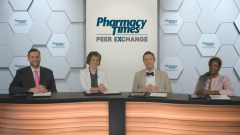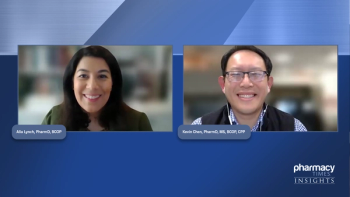
RSV Overview
Ryan Haumschild, PharmD, MS, MBA, leads a panel of medical experts in a discussion regarding adult RSV vaccination.
Episodes in this series

Ryan Haumschild, PharmD, MS, MBA: Hello, and welcome to this Pharmacy Times®Peer Exchange titled “Assessing the Implications of RSV Vaccines in Adults.” My name is Dr Ryan Haumschild. I’m the director of pharmacy services at Emory Healthcare at Winship Cancer Institute in Atlanta, Georgia. Joining me in this discussion are Christina Madison, a TEDx speaker, the founder and CEO of the Public Health Pharmacist, and an associate professor of pharmacy practice at Roseman University of Health Sciences [in Henderson, Nevada]; Mary Bridgeman, a clinical professor at the Ernest Mario School of Pharmacy at Rutgers University [in Piscataway, New Jersey] and an internal medicine clinical pharmacist at Robert Wood Johnson University Hospital [in New Brunswick, New Jersey]; and Adam Welch, an independent vaccine consultant and pharmacist at ETSU [East Tennessee State University] Health [in Johnson City, Tennessee]. Today we’re going to talk about several topics pertaining to RSV [respiratory syntactical virus], including exploring the populations at risk for RSV infections, discussing the available and potential future management of RSV infections, and addressing the barriers related to the introduction of RSV vaccines. Let’s get started.
Let’s talk about the overview of RSV. Ms Bridgeman, how does RSV infection compare with other common respiratory infections in adults? How are they differentiated?
Mary Bridgeman, PharmD, BCPS, BCGP, FASCP: Adults with RSV infection usually either have symptoms or tend to experience mild cold-like symptoms that are consistent with and can mirror any upper-respiratory tract infection, fever, fatigue, cough, rhinosinusitis or rhinitis, and pharyngitis—very generic symptoms. The symptoms appear in stages. It’s not all those symptoms presenting at once. They can be introduced over a period of time. Symptoms often last less than 5 days, but they can persist for up to 2 weeks in some instances. RSV isn’t associated with body aches, which are more typical for influenza. We don’t see the ocular involvement that we see with allergies and taste or sense of smell changes, which are associated with COVID-19.
Ryan Haumschild, PharmD, MS, MBA: I appreciate you going through the symptoms because a lot of us see RSV in patients and we’re confused. How do we differentiate it? How prevalent is it? Mr Welch, how prevalent is RSV among adults? And how prevalent is it among older adults?
Adam C. Welch, PharmD, MBA, FAPhA: If you think about the symptoms you just said, a lot of patients may not have symptoms. That means we don’t know how prevalent RSV truly is. It’s probably severely underestimated because you’re not getting tested.
Mary Bridgeman, PharmD, BCPS, BCGP, FASCP: Absolutely.
Adam C. Welch, PharmD, MBA, FAPhA: You have something viral going on, you feel this upper-respiratory thing, and you may not think that it’s RSV. We did say that it might feel a little different from the flu with its body aches and COVID-19, which has a loss of taste and smell, but the upper-respiratory symptoms are very similar. The prevalence may be underestimated. We know that 60,000 to 160,000 older adults, 65 years and older, are hospitalized with RSV. That number increases with age. Individuals ages 18 to 49 have a lower hospitalization rate; 50 to 64 have a little more; 65-plus, a little more. It’s a significant burdensome disease. It’s probably underestimated in this country due to a lack of testing.
Mary Bridgeman, PharmD, BCPS, BCGP, FASCP: I’ve heard it called the annual hidden epidemic among older adults. I’ve seen estimates, even for acute respiratory illness, that RSV may account for 1% to 14% of cases of acute upper-respiratory issues.
Adam C. Welch, PharmD, MBA, FAPhA: It’s not just an older adult disease. A lot of individuals think RSV is for infants—“that’s what babies get”—but it can affect everyone throughout their life span. Healthy adults may not experience the symptoms that an infant or an older adult would experience, but it’s prevalent across the life span.
Ryan Haumschild, PharmD, MS, MBA: That’s a great overview. If it’s undetected or underrepresented in the population, how do we account for it? How do we become more aware? The question becomes, how do we create a definitive diagnosis for these patients? Are there tests? Is there anything available? I’ll pivot to you, Ms Madison, because this is an area you probably know well.
Christina Madison, PharmD, FCCP, AAHIVP: Absolutely.
Ryan Haumschild, PharmD, MS, MBA: But how are RSV diagnostic tests being utilized for symptomatic patients, with different symptoms? Are they or are they not being utilized?
Christina Madison, PharmD, FCCP, AAHIVP: First, I want to acknowledge and affirm the other comments from our colleagues and state that this is something that’s grossly underestimated, especially now that we’re in this alphabet soup of viruses. Is it the flu? Is it COVID-19? Is it RSV? How do you know? Test, test, test. How do we do that? In a variety of different ways. There are at-home tests that can be used. There are antigen tests or rapid tests that can take anywhere from an hour or less. Then we have PCR [polymerase chain reaction] testing, which looks for the presence of the RSV virus itself. With all those testing modalities, it’s important to note that if you’re not looking for RSV, you’re probably not going to be testing for it. It needs to be something we need to place in the forefront as part of our differential diagnosis for all potential viral infections.
I say this often: if you don’t test, how do you know if you have it? We see this all the time with the flu. Most patients convalesce at home. They think, “I probably have the flu.” How many of those potential cases may have been RSV and have been misdiagnosed because the patient thought they could recover at home and never thought to get a rapid test? Is this testing being utilized? Yes, but probably not to its best benefit. When we see that, if somebody is seeking emergency care, they’re going to the ED [emergency department] or urgent care and presenting with flu-like symptoms and viral upper-respiratory symptoms, they’re likely going to be tested. Are you going to be tested for the full complement to give you a better picture of what you have? We need to be thinking that if it’s a virus, we need to add RSV.
Ryan Haumschild, PharmD, MS, MBA: You made a great case. If I’m going in, it seems there are definitely opportunities to do some of the diagnostic testing to make sure we’re doing a holistic work-up. Another question I have is, with the expansion of PrEP [pre-exposure prophylaxis], are we going to have more opportunities to do testing? Do you think that will impact health care, especially around RSV?
Christina Madison, PharmD, FCCP, AAHIVP: The great thing is that a lot of the testing modalities we have, we can just use 1—either a nasal aspirate or a nasal swab—and test for multiple viruses. Because of that, it’s not any more work. It’s a matter of having the presence of mind to add the additional testing. We don’t have to get any more sampling. We need to run it and make sure it’s being run for not just COVID-19 or the flu but also for RSV. There’s a whole complement of individuals who are at risk and don’t know they’re at risk, or their symptoms are mild, or they’re presenting for something else. It could lead to hospitalization because of secondary bacterial pneumonia, which is what’s likely to increase morbidity and mortality.
Transcript edited for clarity.
Newsletter
Stay informed on drug updates, treatment guidelines, and pharmacy practice trends—subscribe to Pharmacy Times for weekly clinical insights.












































































































































































































